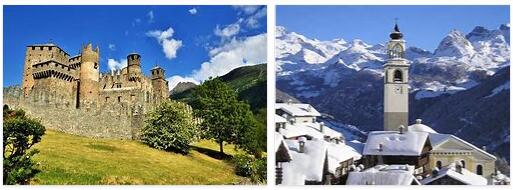Airplane: Italy’s main domestic airlines are Air One, Alitalia and Meridiana. But alsoRyanairflies a number of domestic routes. The main airports are Rome, Pisa, Milan, Bologna, Genoa, Turin, Naples, Venice, Catania, Palermo and Cagliari.
Ships of Tirrenia Navigazioni connect all major port citiesof Italy with each other, including the ports of Sicily and Sardinia. Other ferry companies are Grandi Navi Veloci, Superfast, Ventouris and Montenegro Lines. There are also overnight accommodations from cabins to armchairs.
Large ferries (Navi) head for the ports of Sardinia and Sicily. Smaller islands are approached by smaller ferries (traghetti) and hydrofoils (aliscafi). The main departure ports for trips to Sardinia are Genoa, Livorno, Civitavecchia and Naples. Sicily can be reached from Naples and Villa San Giovanni in Calabria. Sardinian ports are Cagliari, Arbatax, Olbia and Porto Torres. The largest Sicilian port cities are Palermo and Messina.
Rail: Trenitalia is the partially privatized state rail system in Italy. It operates most of the rail connections. There are also some private railway lines.
Rail travel is relatively cheap and the better train classes are comfortable and fast. The different train categories include regional and interregional trains. They stop at almost all train stations. Faster trains, such as the Intercity (IC) or Eurostar Italia (ES), on the other hand, only stop in larger cities. Almost every Italian train station has guarded luggage storage or lockers.
Most Italian trains have first and second class compartments. The first class ticket usually costs twice as much as a second one. Except for Eurostar trains Reservations are not required but can sometimes be beneficial. Reservations can be made in many travel agencies, on the Internet or at the ticket office. There are separate advance booking offices for Eurostar trains at some stations. Carta Verde owners – available at all major train stations – receive a 10 percent discount on national connections and 25 percent on international travel. The Carta d’Argento is specially designed for travelers over 60.
Car: in Italy there is a well-developed network of motorways (autostradas). They are marked on traffic signs by a white A on a green background. The most important north-south connection is the Autostrada del Sole. It stretches from Milan to Reggio Calabria and consists of the A1 from Milan to Rome, the A2 from Rome to Naples and the A3 from Naples to Calabria.
Most of the autostradas have tolls. They can be paid for in cash or by credit card when exiting the motorway. If you want to avoid long waiting times, you can get a prepaid card (Telepass Viacard). It is available from banks and the offices of the Italian Automobile Club.
In addition to the motorways, there are the larger federal highways marked with an “S” or “SS” (Strade Statali). These can be four-lane or two-lane roads. A third category are the provincial roads (Strade Provincali); and finally there are local streets (Strade Locali).
Rental Cars
Tourist offices and many hotels have information about the locations of local car and motorcycle rental companies. The largest international car rental companies with offices in Italy are Avis, Budget, Europcar and Hertz. There is also Italy by Car and Maggiore.
Bus and local transport: All larger cities have a well-developed local transport network – Urbano (city) and Extraurbano (Intercity) – which is served by buses. In addition to the bus network, Rome, Milan and Naples also have the metro (Metropolitante) and Turin the new automated MetroTorino. Only in Venice is local passenger transport used by small boats (vaporetti). An overview of the respective route network is available from the tourist offices. Tickets are available in tobacco shops, kiosks at bus stops or underground stations. In some places there are day and tourist tickets.
Taxi: There are mostly taxi stands at train and bus stations. Radio taxis can also be called by phone. If you make use of this service, you should remember that the meter starts running when you call and not when the taxi arrives. Hailing a taxi on the street is illegal.
Bicycle: Cycling is a popular sport in Italy. Lighting on the bike is an advantage, but not mandatory. Cycling is prohibited on motorways. Bicycles can be taken on trains with the bike logo for a small fee.
